Firmen im Artikel
Advancements in the automation of process plants have resulted in changes to customer requirements. It is becoming increasingly common for plants to be networked and automated, which subsequently increases the complexity of explosion protection. The complex requirements for explosion protection are not due to changes in processes in particular, but rather they are due to the changes in technical capabilities in general. In turn, this means that approaches to problem solving are constantly changing, thus increasing the need for solutions that use tried-and-tested industrial sensor technology, including explosion protection. One thing that is clear is that sensors that increase the productivity and safety of plants in factory automation can also be used in process automation. Difficulties implementing this technology are often due to the significant purchase and maintenance costs of sensors, and especially the complex approvals and certifications required for explosion protection. Customers often want sensors to be fitted in potentially hazardous locations, posing even greater challenges. Based on this premise, Pepperl+Fuchs engineers have developed a solution for optimising customer processes.
Sensor for fall protection device
This is demonstrated by a project undertaken with a manufacturer of fall protection systems for filling tankers with liquids. Fall protection systems are necessary because the process of filling tankers with liquid chemicals is not fully automated – instead, it is always carried out by workers on a platform. This means that one wrong decision by an individual can have far-reaching consequences for people and the environment. Pepperl+Fuchs helped these customers to implement the existing process for non-hazardous areas in hazardous areas. During this process, the R2000 2-D Lidar scanner monitors the position of the fall protection device. The scanner is mounted under the platform railing and scans the area below the device. Before the filling process, if the personnel lower the lifting platform too close to the tank carriage below, the scanner triggers a dual warning signal – a flashing light and audible signal. In addition, the movement of the platform is automatically stopped to allow the personnel to react and use the controls to move the lifting platform into the right position. This eliminates the risk of damage to lifting platforms and railings and even eliminates the risk of crashes, which often result in injury to personnel. This process was implemented in hazardous areas by housing the scanner in an Ex d aluminium housing with an integrated viewing window. The scanner is installed in the housing at a 15° angle to prevent refraction from scattering and distorting signals. This guarantees that the scanner is fully functional. The solution was approved for hazardous zones 1, 2, 21, and 22. This solution allowed the customer to maintain existing structures on the plant and, in turn, enabled its customers to safely monitor the filling process for chemical substances, even in hazardous areas.
Application on an oil platform
Another example is an oil platform in Malaysia. To increase safety for its employees, the oil company was searching for a solution that was capable of enforcing access restrictions for critical areas and documenting employee locations. Pepperl+Fuchs developed a solution by working together with a tracking software company that specialises in this type of application. The software is visualised using a human machine interface (HMI) device that is connected to the central computer. Persons are recorded by a radio frequency identification (RFID) system, which is housed in an Ex d housing and is therefore specially approved for use in potentially explosive environments. Just like in any production facility, employees must first register their presence using a tag to access each area of the oil platform. All process-related information is stored locally on the tag itself, thus enabling track-and-trace applications. Unique identifiers allow raw materials, products, or, in this case, personnel, to be assigned and tracked. The backend software determines whether the employee is authorised to access the area in question. If so, the software unlocks the relevant cabinets and doors. The software simultaneously documents the employee‘s current location. This is particularly important in emergency situations. When an alarm is triggered, information about the exact location of personnel is essential for evacuation purposes.
Determine the fill level
Other sensors are also suitable for use in hazardous areas – for example, sensors using pulse ranging technology (PRT) for object detection. This same technology is also used by the R2000. The sensors are installed in Ex d housings to allow them to monitor a wide variety of different processes. A powerful light source in the sensor emits short pulses that are reflected by the target object and then captured by a highly precise, light-sensitive receiver element. The distance to the target object is then calculated from the values recorded. A Norwegian manufacturer of hoses and flexible tubes for oil production uses this technology to determine the fill level of its storage facility – as you would expect, this involves hazardous areas. The VDM28 sensor installed in the Ex housing enables a measuring range of up 50 m from the reflector. If the fill level is not reached, this triggers automatic processes for filling the position or ordering more materials. The list of examples is endless. Pepperl+Fuchs offers a selection of standardised and certified sensors that are permitted for use in zones 1, 21, 2, and 22.
Pepperl+Fuchs GmbH, Mannheim, Germany












